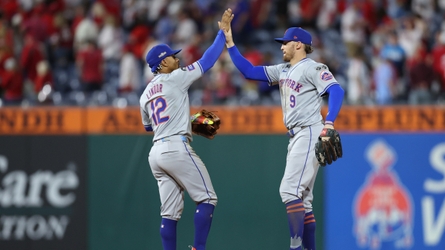This updated version of the Miracle Mets did it again.
At this point, 55 years after their 1969 championship predecessors first earned that nickname, the 2024 Mets deserve to wear that moniker, right?
After all, they’re making the miraculous look practically routine, and under the most extreme pressure a team can face, with so much at stake. For the third time in a week, they rallied in the eighth or ninth innings to score multiple runs and overcome a deficit.
To make it even more remarkable, five of the hitters who helped put together the five-run rally in the eighth inning on Saturday were down in the count 0-2 before delivering hits.
That’s just nuts.
So, in short, they own the late innings in ways you don’t see at this time of the year, certainly not this many times, against some of the best relievers in baseball.
Yet it indeed is happening, as surely as they stunned the Phillies to win Game 1 of the NLDS in Philadelphia by a 6-2 score, overcoming Zack Wheeler’s brilliance and an eighth-inning deficit.
So now they ride this wave of refuse-to-lose momentum into Game 2 on Sunday, assuring themselves, at the very least, of coming home for two games at Citi Field. But anything beyond that is possible the way they’re playing, with a belief they can beat anyone right now.
The Phillies, after all, didn’t just run away with the NL East title. They were a beast at home in Citizens Bank Park with a 54-27 regular season record, largely because of an offense that scored the second-highest total of runs at home in the majors during the regular season.
Yet a tag team of five Mets pitchers shut the Phillies down, allowing them only five hits.
To that point, I’d make the case that the Mets’ decision to start Kodai Senga set the tone in so many ways for everything that happened on Saturday.
Most significantly, it was a choice that sent a message to the players from David Stearns and Carlos Mendoza that they had the confidence to go bold.
It just felt very much in line with the way these Mets have been playing, with a fearlessness that translates to confidence they’ll win, no matter the score, the situation, or the inning.
Senga is their ace, after all. So what if he had started only one game all season, and that was back in July? He dominated the Atlanta Braves that night in late July before straining a calf muscle, and the Mets’ brass believed he wouldn’t wilt under the October pressure, no matter how long he’d been out.
Even knowing he wasn’t likely to go more than two innings, it was still a gamble, and it paid off.
Senga did give up a home run to the first hitter he faced, Kyle Schwarber, but from there he looked very much like the guy who pitched so well in 2023, throwing his ghost fork for swings-and-misses, getting three strikeouts while allowing just one other baserunner, on a walk.
“He was really good,” Mendoza told reporters after the game.
It had to be uplifting for the ballclub, in part because they know Senga perhaps now can play a bigger role if they continue to win.
And it also set up the rest of the game nicely for the bullpen. The Mets were leery of starting David Peterson because of his relief stint on Thursday in Milwaukee, and he certainly wasn’t sharp, but he did gut out three scoreless innings, making big pitches to escape trouble as he left runners in scoring position in each inning.
So that got Mendoza through five innings, where he could use his usual relievers, Reed Garrett for two innings, Phil Maton for one, and finally Ryne Stanek to close in the ninth only because the Mets’ offense gave him the breathing room to stay from the overworked Edwin Diaz.
In a lot of ways it was the perfect outcome for the Mets, saving Diaz (though he did have to get loose when Stanek gave up a run in the ninth) and setting up their two top starters, Luis Severino and Sean Manaea, for Games 2 and 3, not to mention their hottest pitcher, Jose Quintana, for a possible Game 4.
And none of it seemed possible for the longest time on Saturday, as Wheeler was simply overmatching the Mets for seven innings and forcing their fans to agonize over the regret of allowing the right-hander to leave as a free agent five years ago.
Wheeler, who has blossomed into the best postseason starter in baseball over the last three years, was at his most dominant, allowing one hit while striking out nine and racking up a whopping 30 swings and misses, the most anyone in baseball has had since Gerrit Cole had 31 for the Houston Astros in 2019.
But the Mets did make him work hard enough, with some long at-bats, to get his pitch count up enough to force him out of the game, at 111 pitches, after seven innings.
At that point, they probably figured they had the Phillies right where they wanted them.
In truth, though, were you really thinking they would do it again? Isn’t there a legal limit to how many rise-from-the-dead rallies a team can have at this time of year, never mind in a single week?
From Atlanta to Milwaukee to now Philadelphia, the Mets are storming through bullpens, taking no prisoners on the way to who knows where this October.
They’re a long way from a championship but at this point who would deny they have a legitimate chance? The hot teams go deep now; we’ve seen that in recent years with all of these wild card teams, and obviously, nobody is hotter than the Mets.
It’s no fluke, either, what they’re doing with these late-inning rallies. Some of the at-bats were as clinical as they were gritty, whether it was Mark Vientos with a great two-strike approach, hooking a decent slider from Jeff Hoffman for the go-ahead single into left field, or Jose Iglesias fouling off pitch after pitch before singling up the middle in an 11-pitch at-bat.
When asked how they’re doing it, Mendoza didn’t hesitate.
“We know we’re good,” he said.
Good or not, nobody rallies day after day like this with so much on the line.
They haven’t won anything yet, but it’s not too early to call them the Miracle Mets revisited.
Read the full article here























